Physical Address
304 North Cardinal St.
Dorchester Center, MA 02124
An understanding of the superficial anatomy is essential to explore the knee in a correct manner ( Fig. 89.1 ).
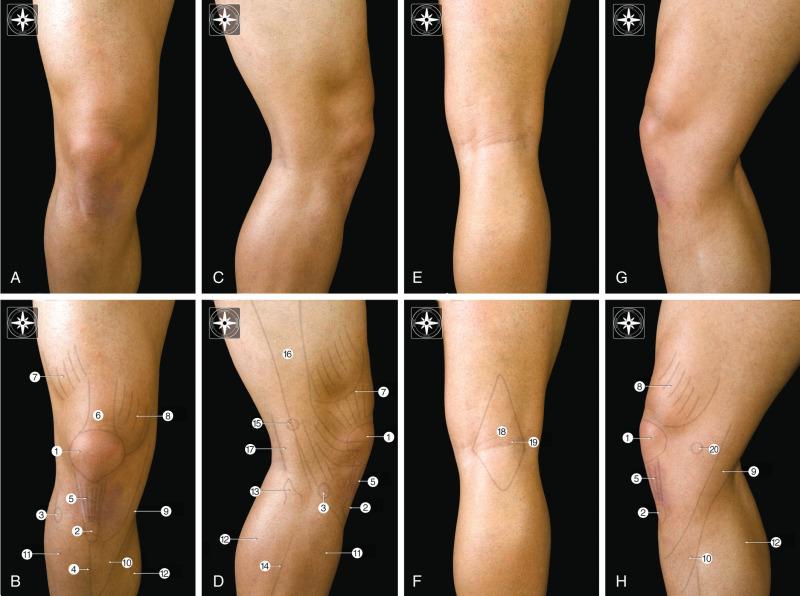
When the knee is viewed from the anterior aspect, the presence of the patella is highlighted. It is located in the center of the joint, and on its anterior face, the entire perimeter of the patella can be palpated. The motion of the patella from lateral to medial and from proximal to distal can functionally vary based on the position of the knee and the contraction of the quadriceps femoris muscle. The more extended the knee and the more relaxed the quadriceps femoris muscle, the more mobile the patella will be, whereas as the knee flexes, the patella follows the femoral trochlear groove (patellar surface) and becomes more immobile. On the other hand, the normal superficial appearance of the patella can be altered by inflammatory processes that affect the prepatellar bursa, which can cause the typical morphologic appearance of the anterior knee to disappear.
On the superior border of the patella, the tendon of the quadriceps femoris muscle can be palpated, and on either side, the vastus medialis and lateralis, components of the same muscle, can be palpated. At the level of the apex of the patella, and directed distally, the patellar tendon can be identified as it descends to the tibial tuberosity, which is easily visible and palpable. This tuberosity continues distally with the anterior border of the tibia. Lateral to this anterior border, the muscle masses of the anterior compartment of the leg can be palpated, specifically the tibialis anterior muscle, and lateral and proximal to this tuberosity the anterior tubercle or Gerdy tubercle can be palpated, which constitutes the point of insertion for the iliotibial tract. Medial to the tubercle, palpation can lead to recognition of the insertion, on the medial aspect of the tibia, of the tendons of the sartorius, gracilis, and semitendinosus muscles, also known as the pes anserinus tendons. The most superficial structure corresponds to the sartorius muscle, and deep to this muscle, the tendons of the gracilis and semitendinosus muscles can be appreciated. At the upper limit of the pes anserinus, the cordlike tendon of the gracilis muscle can be palpated, which is located about 2 cm distal to the tibial tubercle. This understanding will prove useful during anterior cruciate ligament (ACL) reconstruction with use of autograft tendons from the pes anserinus (hamstring tendons).
Approximately two fingerbreadths proximal to the tibial tubercle, and on either side of the patellar tendon, the femoral condyles, medial and lateral, and the proximal region of the tibia or the tibial condyles can be palpated. The femoral and tibial condyles can be palpated most easily with the knee in 90 degrees of flexion. In this position, the space delineated between the femoral and tibial condyles forms a triangle on either side of the patellar tendon. This triangle, which by palpation corresponds to a soft spot, is where the anteromedial (AM) and anterolateral arthroscopic portals can be positioned. On the other hand, in cases of articular effusion, which is frequently associated with intra-articular pathology of the knee, the appearance of this triangular space can be more difficult to appreciate.
In the lateral region of the knee, distal to the lateral condyle of the tibia, the prominence of the fibular head can be observed. With the knee flexed to 90 degrees, and with varus articular force, one may palpate, and occasionally visualize, a cordlike structure that runs from the fibular head to the lateral condyle of the femur. This structure corresponds to the lateral collateral ligament (LCL). At the same level, but in the medial region, the medial collateral ligament (MCL) can be found, but because it is a flat structure, it is not possible to see or palpate it.
In the posterior region, osseous structures cannot be observed because they are covered with muscular structures. From a posterior view, with the knee in extension, a space that forms a rhombus can be appreciated; this space is called the popliteal fossa. This view is more easily defined when the patient actively flexes the knee. The popliteal fossa is traversed, in its medial zone, by a horizontal line that corresponds to the flexion crease of the knee. The edges of this rhombus correspond to the margins or limits of different muscle groups and the center of the popliteal fossa.
The inferior borders of the popliteal fossa correspond to the medial and lateral head of the gastrocnemius muscle, which are divergent at their origin but converge distally to reunite with the soleus muscle to form the calcaneal or Achilles tendon. The superomedial border corresponds to the tendons of the semitendinosus superficially and the semimembranosus deeply at their musculotendinous junction. With the knee flexed, these tendons are more easily appreciable, and they can even be pinched between one's fingers. In persons in whom the pes anserinus tendons have been used as an autograft for ACL reconstruction, this border may disappear or may appear altered. Finally, the superolateral border corresponds to the tendon of the biceps femoris, on its path to its insertion on the fibular head. At this level, one can begin to appreciate the thick iliotibial tract.
In the popliteal fossa, one can palpate diverse neurovascular structures: the tibial nerve, the common peroneal nerve, and the popliteal artery. The tibial nerve is encountered in the medial region of the popliteal fossa and can be recognized as a thick cordlike structure. One technique to highlight the nerve during exploration consists of placing the patient in the lateral decubitus position with the hip flexed to 90 degrees. In this position, one maintains the patient's knee slightly flexed with the ankle in dorsiflexion. Using the index finger, the hand can be passed from the inferior portion of the knee toward an anterior position and the nerve palpated. The common peroneal nerve can be localized in the lateral region of this fossa. With the knee in flexion, by sliding the index finger laterally, one may palpate a cordlike structure that is much smaller than that of the tibial nerve. The popliteal artery can be localized medial to the tibial nerve and is easily recognizable by palpation of its pulse.
The knee contains three osseous components: the femur, the tibia, and the patella ( Fig. 89.2 ). These three structures form the tibiofemoral and the patellofemoral articulations, which together comprise the knee joint. In the lateral region of the knee, a third articulation is encountered, the proximal tibiofibular joint, which does not truly participate in the flexion-extension movement of the knee but is involved in the lateral stability of the knee via the insertion of the LCL and the biceps femoris tendon onto the fibular head.
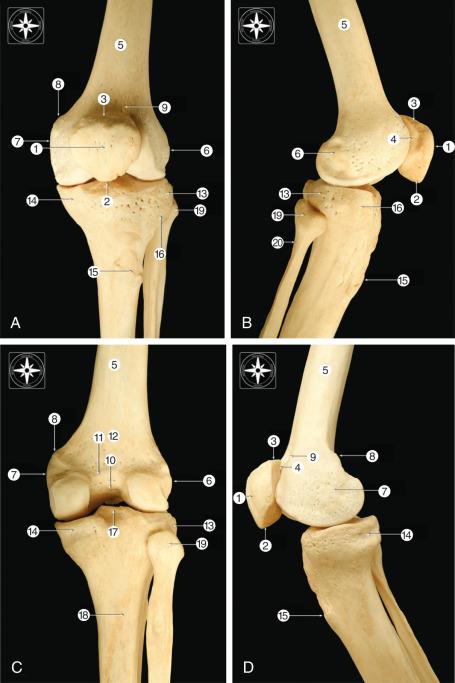
The distal region of the femur is formed by the two condyles, one medial and one lateral. A prominence named the lateral epicondyle is located on the lateral condyle, and the LCL inserts onto this prominence. At the level of the medial condyle is the adductor tubercle, and anterior and distal to this tubercle lies the medial epicondyle, the origin of the MCL.
Both femoral condyles, which are united at the anterior level by the femoral trochlear groove (patellar surface), are separated at the posterior level by a great notch—the intercondylar notch. The femoral trochlear groove permits the patella to slide during the movements of knee flexion and extension. The intercondylar notch is the point of proximal insertion of the ACL and the posterior cruciate ligament (PCL). A wide zone on the medial wall of the notch constitutes the origin of the PCL, whereas the lateral wall has a flattened area that represents the proximal origin of the ACL. This area includes discrete bony prominences that are used as landmarks for the reconstructive surgery of the ACL. The prominences that are referenced for the correct positioning of the osseous tunnels are the lateral intercondylar ridge (LIR) and the lateral bifurcate ridge (BR). The lateral BR is located perpendicular to the LIR, and in their posterior margin, an imaginary “T” is formed between them. The LIR is considered the anterior limit of the ACL, and the lateral BR represents the separation of the two bundles (AM and posterolateral [PL]) of the ACL. Because of the confusion of the LIR with the posterolateral rim of the intercondylar notch during localization of the femoral tunnel for anterior ligamentoplasty, this prominence is now popularly called resident's ridge ( Fig. 89.3 ).
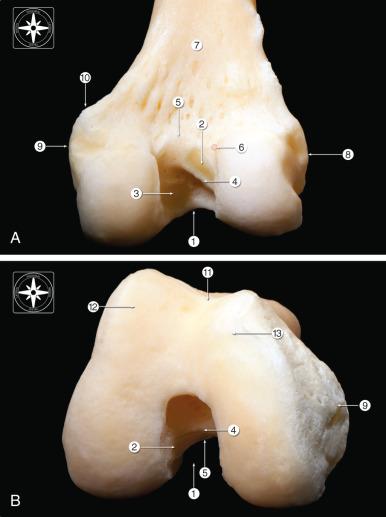
The proximal epiphysis of the tibia forms two flattened surfaces, named the tibial plateaus or condyles. The medial tibial surface is larger and its shape is almost flat, whereas the lateral surface is more narrow and convex. Both present posterior declination of approximately 10 degrees with respect to the tibial diaphysis. At the posterior level, the lateral tibial condyle presents a flat and oval articulation with the fibula. In its most posterior zone, the medial tibial condyle presents a deep transverse groove for the insertion of the semimembranosus muscle (reflected tendon) and another medially for the insertion of the MCL.
The central region, located between the tibial plateaus, is occupied by the intercondylar eminences with the medial and lateral spines (medial and lateral intercondylar tubercle). Anterior and posterior to these eminences one can find the anterior and posterior intercondylar areas, respectively, which offer insertion for the cruciate ligaments and menisci.
The tibial tuberosity protrudes on the anterior face of the tibia, which corresponds to the insertion of the patellar tendon. Approximately 2 to 3 cm lateral to this tuberosity, the anterior tubercle or Gerdy tubercle is encountered, which constitutes the point of insertion for the iliotibial tract.
The patella is the largest sesamoid bone in the human body. It has a triangular shape, and we can highlight three edges, two surfaces, and one apex. The anterior surface is separated from the skin by the prepatellar bursa. The posterior or articular surface is divided by a central ridge into a medial articular surface and a larger lateral surface that occupies approximately two-thirds of the patella ( Fig. 89.4 ).
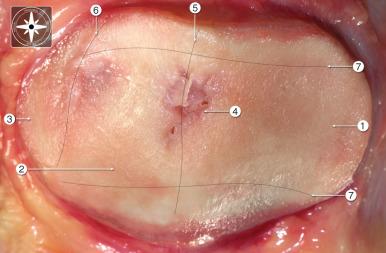
The superior edge (base) of the patella is the location of insertion for the fibers of the tendon of the quadriceps femoris, principally the rectus femoris, vastus lateralis, and vastus intermedius. Most of the fibers of the vastus medialis insert on the medial edge; only a small portion insert along the superior edge. The fibers of the quadriceps femoris tendon envelop the anterior surface of the patella and merge at the level of the patellar vertex with the patellar tendon or ligament ( Fig. 89.5 ).
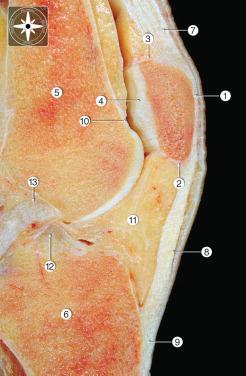
The muscles that act on the knee joint may be divided schematically and with regard to their location into four groups ( Fig. 89.6 ): anterior, posterior, medial, and lateral. In some anatomy texts these muscle groups are referred to as dynamic elements of the knee, but instead of following that discussion in this chapter, we only refer to them with regard to their origin and insertion and provide some anatomic detail that may prove useful to the reader.
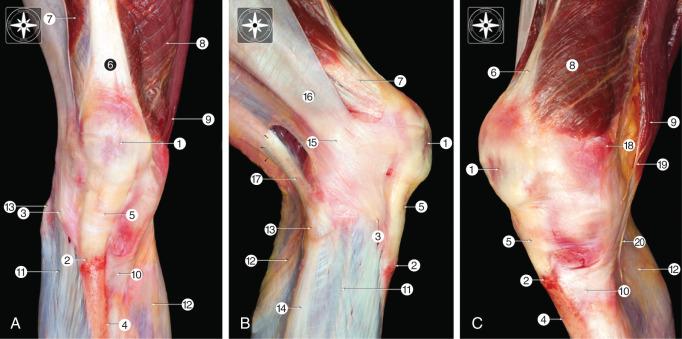
The anterior group is formed by the quadriceps femoris muscle, which is the primary extensor of the knee joint. It is formed in turn by four muscular components, the rectus femoris (which also functions as a hip flexor), vastus intermedius, vastus lateralis, and vastus medialis. The insertion of this muscle at the level of the base of the patella has been described previously in the osseous anatomy section.
In the posterior region of the knee and in its most proximal zone, three muscles belonging to the posterior muscle compartment of the thigh may be observed: the semimembranosus and semitendinosus (more superficial) muscles on the medial side and the biceps femoris muscle on the lateral side, all of which act as knee flexors. In the distal zone, the popliteus muscle and the gastrocnemius muscle, muscles of the posterior compartment of the leg, deep, and superficial, respectively, also have a flexor function.
The semimembranosus is one of the hamstring muscles. The distal semimembranosus tendinous insertions are important structures that contribute to the stability of the posterior medial corner of the knee. The semimembranosus inserts at the posterior level of the knee joint through five tendinous expansions: the anterior or tibial expansion (the reflected expansion), the direct expansion, the inferior or popliteal expansion, the capsular expansion, and the oblique popliteal ligament. The anterior expansion extends anteriorly, passing under the posterior oblique ligament, and inserts in the medial aspect of the proximal tibia under the MCL. The direct expansion also has an anterior course, deep to the anterior arm, and attaches in the posterior medial aspect of the tibia. The inferior expansion extends more distally than the anterior and the direct expansions. It passes under the distal tibial segments of the posterior oblique ligament and the MCL, inserting just above the tibial attachment of the MCL. The capsular expansion is adjacent to the posterior oblique ligament. The oblique popliteal ligament is a thin, broad lateral extension of the semimembranosus tendon that covers and blends with the posterior medial capsule and extends beyond the midline of the joint to intertwine its fibers with the arcuate ligament from the lateral posterior aspect of the knee ( Fig. 89.7 ).
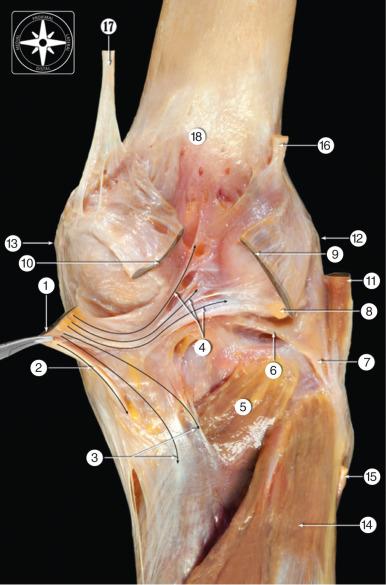
The popliteus muscle originates on the posterior aspect of the tibia and inserts on the lateral femoral epicondyle. Because of its multiple attachments to other posterior and posterolateral structures, the popliteus muscle is an important structure that provides dorsolateral stability, stabilizes the lateral meniscus, and balances the neutral tibial rotation. This muscle possesses a tendon of some 2.5 cm in length that runs across a hiatus located in the segment medial and posterior to the lateral meniscus, making its visualization possible during arthroscopic exploration of the knee.
The gastrocnemius muscle comes from the lateral and medial femoral condyles through two heads of origin. Together with the soleus and plantaris muscles, they form the superficial posterior compartment of the leg.
The medial musculature of the knee includes two muscles, the sartorius muscle of the anterior compartment of the thigh and the gracilis muscle of the medial or adductor compartment of the thigh. These muscles act at the level of the knee as flexors and internal rotators of the leg. Their insertion on the medial region of the tibia is characteristic and, together with the insertion of the semitendinosus muscle, is known as the pes anserinus (see Figs. 89.6C and 89.8 ). Knowledge of the anatomy and position of these tendons at the level of the pes anserinus is fundamental to correctly harvest autografts during reconstruction of the ACL or PCL.
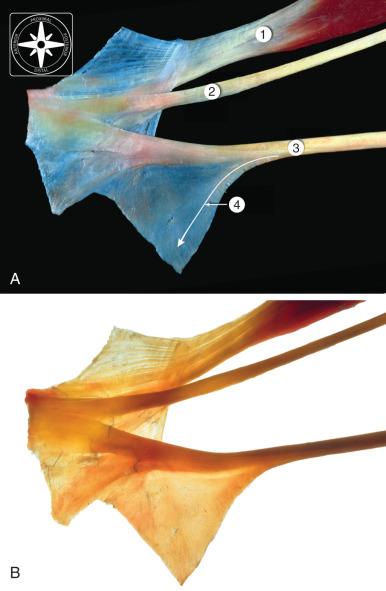
The pes anserinus insertion is, on average, 19 mm (range, 10 to 25 mm) distal and 22.5 mm (range, 13 to 30 mm) medial to the apex of the tibial tubercle, with an average width of 20 mm (range, 15 to 34 mm). The sartorius inserts more anterior and superficially than the gracilis and the semitendinosus, and forms an aponeurotic fascia. On the superior margin of this fascia is a thickened band that can be confused with the tendon of the gracilis, which is immediately distal. This confusion at the moment of obtaining the graft would result in a tendon of smaller length and attached to a muscle belly. Posteriorly, and deep to the sartorius, lies the tendon of the gracilis at the proximal level and the tendon of the semitendinosus muscle at the distal level. These last two tendons can be used for ACL reconstruction procedures. Both tendons (semitendinosus and gracilis) have tendinous expansions directed toward the fascia of the medial head of the gastrocnemius muscle that need to be sectioned for correct harvesting of both tendons. If these expansions are not carefully freed from the tendons, the tendon stripper can inadvertently transect the main tendon, leaving the surgeon with a shortened graft (see Fig. 89.8 ).
The tendon of the biceps femoris muscle is the only tendon located at the lateral side of the knee. Its insertion is formed by three bands: one that is directed to the lateral part of the fibular head; another to the lateral condyle of the tibia, where it merges with the iliotibial tract; and finally a third one that comprises the deep fascia of the lateral part of the leg, where it coincides with the joint capsule of the knee. This muscle is a flexor at the level of the knee and an external rotator for the leg.
The knee has a system of bursae that is the most extensive and complex in the human body. Twelve bursae are described. However, based on their clinical importance, only the prepatellar, superficial infrapatellar, anserine, and gastrocnemius bursae are described.
The prepatellar bursa is located in the anterior region of the knee, at the subcutaneous level, anterior to the inferior half of the patella and to the superior half of the patellar tendon. Inflammation of this bursa is known as housemaid's knee .
The superficial infrapatellar bursa is also located in the anterior aspect of the knee and similarly in the subcutaneous plane, above the distal limit of the patellar tendon and the tibial tuberosity.
The anserine bursa is in the medial aspect of the knee. This bursa is located three fingerbreadths below the medial joint line and between the medial surface of the tibia, the MCL, and the tendons of the pes anserinus at the level of their insertion.
Two bursae are found in the posterior area, located deep between the heads of the medial and lateral gastrocnemius and the posterior joint capsule. The lateral subtendinous gastrocnemius bursa rarely communicates with the knee joint, but the medial bursa does so commonly. In certain occasions, the medial subtendinous gastrocnemius bursa may enlarge and create a space known as a Baker or popliteal cyst .
The menisci, medial and lateral, are two half-moon–shaped fibrocartilage structures that cover the peripheral portion of the medial and lateral tibial condyles. In section, they are triangular with a peripheral base. Their superior surface is slightly concave, whereas the inferior is flat, adapting to the articular surface of the femoral and tibial condyles, respectively. Each meniscus is differentiated into 1) the center or meniscal body, 2) the meniscal ends or anterior and posterior horns, and 3) their attachment to the tibial surface, the meniscal roots ( Fig. 89.9 ).
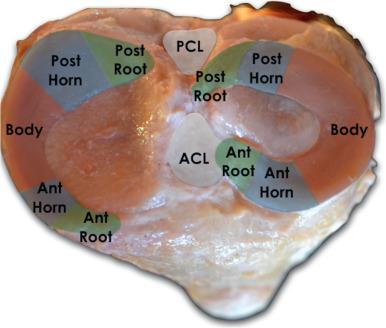
They are also inserted into the tibial condylar ridge through their capsular union or coronary ligament. In 50% to 90% of knees, the anterior horns are connected by a dense fibrous band named the anterior transverse ligament, anterior intermeniscal ligament, or anterior transverse geniculate ligament. Both menisci slide with flexion and extension of the knee. The degree of this movement is larger for the lateral meniscus, with 9 mm, compared with 3 mm for the medial meniscus.
The medial meniscus possesses a semilunar or “ C ” shape. Because of its strong insertions at the level of the body and posterior horn, this meniscus is less mobile than the lateral and is exposed to a greater risk of injury. Anteriorly the meniscus does not have a connection to the capsular tissue or fat pad. Whereas in its medial portion it is firmly inserted into the deep capsular ligament, in its posterior body the meniscus is firmly fixed by the oblique popliteal ligament to blend with the joint capsule.
The lateral meniscus is almost circular, with an “ O ” shape. Because of the poor union of the meniscus to the margin of the lateral tibial condyle and the absence of insertion in the zone where the popliteus tendon courses, the meniscus possesses a mobility that relatively protects it from injury. In 69% to 74% of knees, a dense fibrous band can be observed arising from the posterior meniscal horn and running upward and posteriorly to the PCL; it inserts on the medial femoral condyle, known as the posterior meniscofemoral ligament or the ligament of Wrisberg. In approximately 50% to 74% of knees, another fibrous band can be observed arising from the posterior horn and passing upward and in front of the PCL, also terminating on the medial femoral condyle; it is named the anterior meniscofemoral ligament, or the ligament of Humphry ( Fig. 89.10 ).
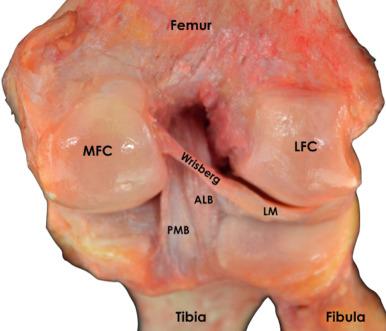
Because many functions of the meniscus have been described, its resection can cause mechanical alterations that can lead to degenerative articular changes. For this reason, avoidance of complete meniscal resection is advised. The degree of osteoarthritis (OA) and the time until OA onset are likely most dependent on the volume of meniscus taken at the time of surgery, as studies have shown that increasing meniscectomy size results in reduced contact area within the knee joint and thus greater contact pressures on the cartilage in the ipsilateral compartment.
The ACL extends from the distal femur and attaches to the anterior medial portion of the tibia. The average width of the midsubstance of the ACL is 10 to 11 mm, with a range of 7 to 17 mm and a thickness of 3.9 mm. The isthmus (region of the ACL with the smallest cross-sectional area) is located an average 53.8% of the distance from the tibial insertion center to the femoral insertion center. The cross-sectional area at the isthmus is smallest in extension and increases with flexion. The ACL is formed by two bundles, the AM and PL, which are named according to their tibial insertion site. Each bundle comes into play at different points of knee flexion, as the ACL is not isometric. The load in the ligament shifts from bundle to bundle as the knee flexes throughout a normal range of motion (ROM).
The LIR of the femur is present in 94% to 97% of human femora. In an arthroscopic evaluation of 60 patients undergoing ACLR, Ferretti and associates visualized the LIR in 100% of patients. The anterior margin of the ACL femoral attachment site is an average distance of 0.5 mm from the proximal part of the LIR. The center of the ACL femoral attachment is an average of 1.7 mm proximal to the BR, with the AM bundle attachment center 4.8 mm proximal to the BR and the PL bundle attachment center 5.2 mm distal to the BR.
The ACL is composed of thick sporadic bundles of collagen fibers encased in loose connective tissue. The random fiber arrangement gives the ligament a higher tensile strength than many other ligaments. The ACL is composed of two major types of fibers: one with a nonuniform diameter, which resists tensile forces, and one with a uniform diameter, which resists shearing forces. The nonuniform diameter fibers account for 50.3% of the ACL and have a diameter ranging from 25 to 85 nm. The uniform diameter fibers account for 43.7% of the ACL and have a diameter of 45 nm. Elastic fibroblasts run between the larger fibers and account for the remaining 6% of ACL tissue.
With the knee in extension, the femoral insertion site of the PL bundle is posterior and inferior to the AM bundle on the lateral femoral condyle (LFC). Other studies have suggested that, approximately 2 to 3 mm from its femoral attachment, the AM and PL bundles connect to form a flat “ribbon” without a clear separation between the two. At the tibia, the ACL inserts in an elliptical (51%), triangular (33%), or “ C ”-shape (16%). The anterior lateral (AL) meniscal root inserts deeply beneath the ACL, with an average distance from the center of the ACL to the AL meniscal root attachment of 5.0 mm and an ACL-AL root overlap of 88.9 mm ( Fig. 89.11 ).
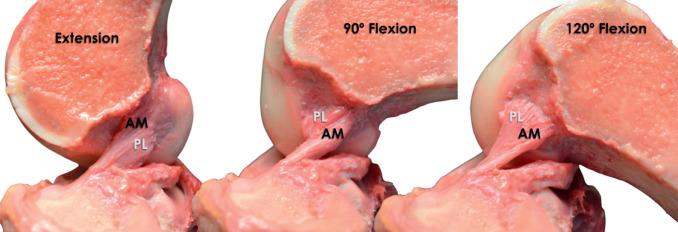
The PCL inserts in the posterior intercondylar area of the tibia and is directed to its attachment on the roof of the notch and the medial wall of the femoral intercondylar notch. As with the ACL, the presence of two different bundles has been described, the anterolateral (AL) and the posteromedial (PM). In complete extension, the PM bundle of the ligament encounters more tension than the AL bundle, whereas during flexion, the PM fibers relax and the AL fibers are taut ( Fig. 89.12 ).
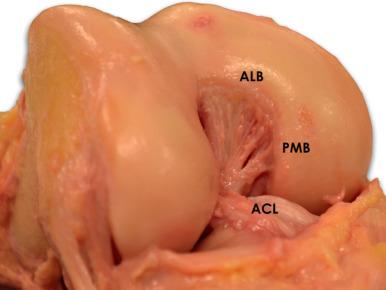
The MCL, with a more or less triangular shape, is an intrinsic ligament that is intimately related to the medial meniscus and joint capsule, forming the medial meniscoligamentous complex. This ligament has two layers, one deep and the other superficial. The fibers of the deep layer extend from the medial femoral condyle to the medial tibial condyle. The fibers of the superficial layer extend like a fan from the medial epicondyle to the medial tibial condyle, posteriorly to the insertion of the pes anserinus, approximately 10 cm distal to the medial joint line. It then merges with the posterior joint capsule, where they form a strong capsular reinforcement known as the posterior oblique ligament ( Fig. 89.13 ).
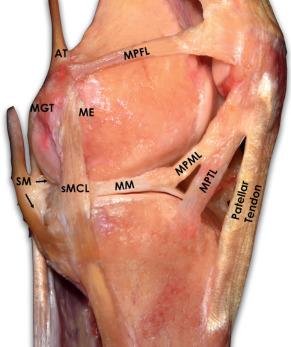
Become a Clinical Tree membership for Full access and enjoy Unlimited articles
If you are a member. Log in here